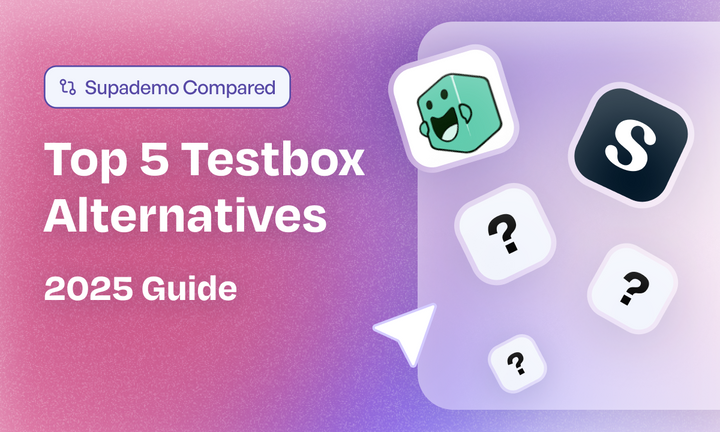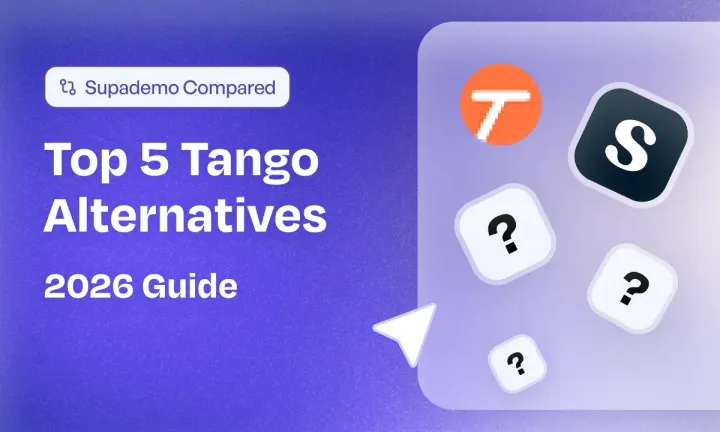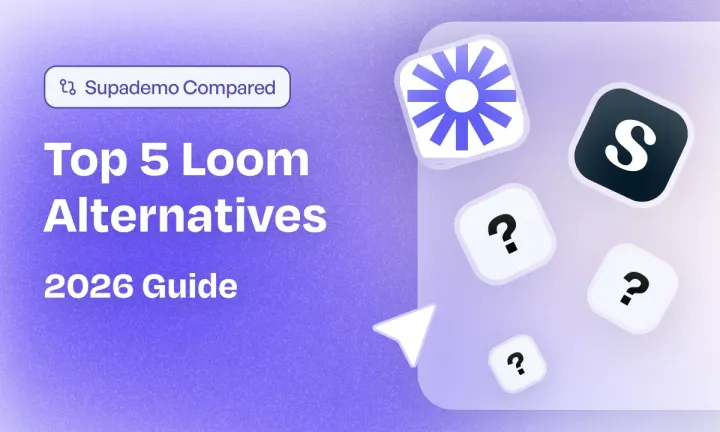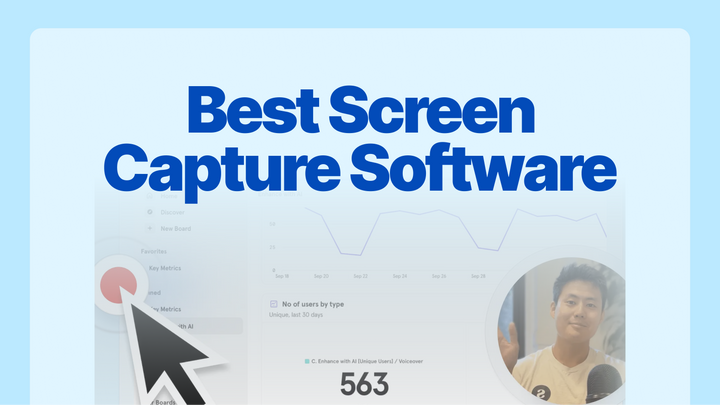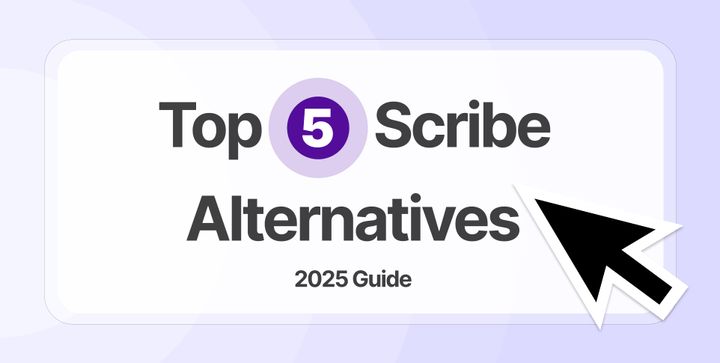Considering TestBox for demo and POC automation but exploring alternative software solutions? While TestBox offers powerful capabilities for creating personalized product demos, you might be wondering what other options are available – across features, pricing, support, and scalability – before making your final decision.
In this comprehensive guide, we've taken a no-shortcuts approach to finding and identifying the best alternatives to TestBox for demo and POC automation. By diving into hundreds of authentic reviews on G2 and Gartner, connecting with sales teams across various communities, and thoroughly testing more than 20 platforms ourselves, we've pinpointed the top 5 TestBox alternatives that deliver outstanding results for generating reliable, personalized demo experiences at scale.
Before we jump into our top 5 TestBox alternative picks, here's the methodology through which we selected the demo automation vendors.
✅ Tested each platform's core demo creation capabilities
✅ Gathered feedback from teams actively using these tools
✅ Focused on solutions that work for different company sizes and budgets
✅ Considered factors like ease of use, customization options, and support quality
Now, let's explore each TestBox alternative and see how they can help you create better product demos, close deals faster, and improve your onboarding process.
Why do customers explore alternatives to TestBox? (with proof)
While TestBox offers robust demo creation capabilities, the implementation process can be time-intensive, often requiring several weeks of setup.
Additionally, some users report performance limitations and concerns about lengthy contract commitments, with pricing that may stretch enterprise budgets.
Based on reviews from hundreds of customers, here are the key reasons companies search for TestBox alternatives.
Reason #1: Limited demo environment customization and real-time editing constraints

TestBox's strict controls on demo environment modifications create significant barriers for sales teams needing to demonstrate dynamic product scenarios. While the platform excels at generating pre-configured demos, its restrictive approach to real-time customization limits sales representatives' ability to adapt demonstrations on the fly during customer conversations.
Users frequently express frustration with the inability to make spontaneous adjustments to demo accounts, such as creating new data points or modifying workflows during live presentations. As one user noted:
These limitations often force sales teams to request new demo environments or schedule follow-up sessions when prospects ask to see specific scenarios that weren't pre-configured, potentially disrupting the sales momentum and extending the sales cycle unnecessarily.
Reason #2: Incomplete feature coverage and inconsistent demo environments


One of the most significant challenges users face with TestBox is its inability to showcase a product's complete feature set within the demo environment. This limitation often forces sales teams to maintain multiple demo tools or rely on sales engineers with access to the actual product, creating a fragmented demonstration experience.
Users consistently report gaps in available functionality and the need to switch between different environments during demos. As multiple users have noted:
Further complicating the demo process is the inconsistent setup of different features within the platform. Sales teams often struggle with varying levels of functionality across different sections:
This inconsistency and incomplete feature coverage can lead to disjointed presentations and potentially undermine the sales team's ability to effectively demonstrate their product's complete value proposition.
What are the best alternatives to TestBox in 2026?
Now that we've discussed some of my main reasons customers search for TestBox alternatives, let's dive into some of its leading competitors in the demo automation space.
For this comprehensive article, we researched by directly trying out dozens of interactive demo platforms, talking to real users, and reading hundreds of real customer reviews from reputable software rating sites like G2 and Gartner.

This ultimately led us to 5 of the best TestBox alternatives – each with unique strengths, weaknesses, and use cases. In the next section, we’ll break down each demo automation platform's core functionalities, top use cases, pricing model, and drawbacks to help you make the best decision for your company.
1. Supademo
Unlike TestBox, Supademo is a fast and easy demo automation platform that lets you create interactive demos in both screenshot/video and HTML formats in under 5 minutes.
The platform's team-focused features lend themselves to malleable use cases across customer success, onboarding, marketing, or sales enablement.
Over 100,000 professionals at companies like Turo, Microsoft, HeyGen, Beehiiv, Alibaba, and Pokemon leverage Supademo to drive product understanding and adoption.
How does Supademo compare to TestBox?
As mentioned above, TestBox has significant limitations - starting with its limited features and editing capabilities, which can hinder teams from fully leveraging the tool.
When it comes to value, the difference is clear. While TestBox starts at a steep annual subscription with no trial option, Supademo offers more features at a fraction of the cost - just $27/month. Users can access capabilities TestBox doesn't offer, including AI voiceovers in 15+ languages, desktop recording, native Figma integration, custom voiceover options, etc.
The platform's flexibility extends to its recording options. Whether you're capturing screenshots, recording videos, using the Figma plugin, or uploading media, Supademo makes it easy to create demos that match your exact needs.
| Feature | Supademo | TestBox |
|---|---|---|
| Best for | Customer Success, Sales, Onboarding, Marketing | Sales |
| Pricing | Starts at $27/mo | Starts at $38,000/year |
| Learning curve | ✅ #1 on G2 for ease of setup | ⛔️ Complex setup (#10 on G2 for ease of setup) |
| Recording Type | HTML, Screenshot, Video, Figma Plugin, Video/Image Uploads | HTML |
| Independent demo environment | ✅ Yes | ⛔️ No |
| Post-sales call demos | ✅ Yes | ⛔️ Limited availability |
| Team collaboration | ✅ Free and paid team members | ⛔️ Paid seats only |
| AI voiceovers | ✅ Yes (15+ languages) | ⛔️ No |
| Record your own voiceovers | ✅ Yes | ⛔️ No |
| AI text generation | ✅ Yes (15+ languages) | ⛔️ No |
| Conditional branching | ✅ Yes | ⛔️ No |
| Time to launch | ✅ | ⛔️ 45+ days |
| Detailed analytics | ✅ Yes | ✅ Yes |
| Support | ✅ Yes (including free plans) | ⛔️ Paid plans only |
| Figma Plugin | ✅ Yes | ⛔️ No |
| Free trial | ✅ Yes | ⛔️ No |
| Free plan | ✅ 5 interactive demos | ⛔️ No |
When it comes to features and functionality, Supademo offers a bevy of unique features that allow customers to get the most out of their platform:
Unique features Supademo has that TestBox does not have
Supademo's multi-demo showcase feature allows users to group related or complementary interactive demos into a single, shareable page.
This leads to two clear benefits:
1. Unified presentation: Customers can combine multiple Supademos into one cohesive collection, making it easier to present complex products, workflows, or use cases. Showcases can be shared via a single trackable URL or embedded on websites – simplifying distribution.
2. Flexible, self-paced viewing experience: Viewers can navigate through multiple demos in a non-linear manner, jumping to specific sections at their own pace. This flexibility is particularly useful for onboarding or demo leave behinds, where users can focus on the most relevant information for their needs.

This feature allows you to trigger any Supademo or Showcase as an overlay on top of your product experience – helping you highlight new features, product tutorials, or onboarding guides in-context.
You can easily trigger any Supademo from your workspace through click events or programmatically via JavaScript, helping increase the surface area for driving product adoption and user engagement.

With Supademo – you can mix and match synthetic AI voiceovers with your own, personal voiceover for a more personalized experience.
When it comes to the AI voiceover experience, choose from multiple languages, tones, accents in any language. Want even more personalization? You can even record your screen, camera, or both and add it as a step or slide within the Supademo.

While TestBox primarily focuses on sales demos with basic sharing capabilities, Supademo takes demo sharing to the next level with versatile options that work for every team:
Quick Sharing & Distribution
• Share your demos instantly through links for email, chat, or apps
• Create unique trackable links with engagement notifications, embed them anywhere from docs to LMS platform
• Secure sensitive content with password protection.
Advanced Export Options
• Export your demos as MP4 videos for social media
• Convert demos to detailed SOP guides for documentation
• Create engaging GIFs for newsletters, websites, etc.
This flexibility means your demos don't just live in one format – create once, share everywhere. Whether you need a quick GIF for Twitter, an SOP guide for your knowledge base, or a comprehensive product walkthrough for customer onboarding, Supademo lets you repurpose your demos instantly without recreating them from scratch.

Create true-to-life product demos in minutes with Supademo's HTML recorder.
Unlike traditional screen recordings, Supademo captures the complete HTML and CSS of your application, preserving all interactive elements, hover states, and animations.
The result? A pixel-perfect replica that lets users explore your product just like the real thing. Edit content, swap data, or personalize the experience after recording - all without touching code. Share your interactive demos anywhere or embed them seamlessly, knowing they'll maintain their fidelity and functionality wherever they're viewed.
Seamless, on-demand product education inside your app.
Supademo’s In-app demo hubs let you organize and embed interactive process guides directly within your product. Users can instantly search, explore, and follow step-by-step demos without switching tabs or opening external documents.
Ideal for onboarding, training, and SOP documentation, Demo Hubs ensure users always have the right guidance in context. Teams can easily add or update demos with no code, keeping documentation accurate, accessible, and always up to date.
But don't take it from us – hear from real customers


Looking at customer feedback and market rankings, Supademo consistently emerges as the leading TestBox alternative. G2 and other review platforms rank Supademo as a Demo Automation Leader, scoring higher than TestBox in critical areas like easy of setup, support quality, and ease of admin.
Real user reviews highlight that while both platforms offer similar distribution capabilities, Supademo delivers more features at a significantly lower price point, making it a more cost-effective choice for teams looking for powerful demo creation tools.
Users today want a tool that helps them achieve their goals while getting out of the way – without being overly slow, clunky, or challenging to use. It's fair to say that Supademo is a better option than TestBox for teams that prioritize ease of use, faster time-to-value, and getting more for their dollar.
Supademo Pros & Cons
✅ Quick demo creation - ready to share in about 3 minutes
✅ Versatile recording options, including HTML, screenshots, videos, screen+webcam, and file uploads
✅ Simple and intuitive editing interface
✅ Flexible use across teams - from sales and marketing to customer success and training
✅ Multiple sharing formats: trackable links, website embeds, in-app guides, and demo collections
❌ Integration options are currently limited to major platforms (HubSpot, Salesforce, Marketo, Zapier, Google Analytics, Slack)
2. Demoboost

Demoboost is an enterprise-level demo platform designed for both marketing and pre-sales demonstrations. The platform has unique capabilities such as video overlays on HTML-based demos, internal feedback systems, and A/B testing functionality.
Key Demoboost Features

- Live Demo Support: The platform equips sales teams with customizable speaker notes and real-time analytics during live sessions, tracking viewer engagement metrics and dropout points to optimize demo performance.
- Internal Collaboration Tools: Teams can work together within the demo environment itself, adding comments and rich media elements like images and videos to enhance demonstrations.
- A/B Testing Capabilities: Users can experiment with different CTAs and messaging across demos while tracking engagement metrics for optimization.
Demoboost Pricing
Demoboost operates on a custom pricing model without public rates. The platform requires direct contact with their sales team for pricing details, and notably, there's no self-serve signup option or free trial available.
Demoboost Pros & Cons
✅ Comprehensive live demo features with speaker notes
✅ Built-in collaboration and feedback tools
✅ Strong integration ecosystem (HubSpot, Clearbit, Slack)
✅ Advanced team collaboration capabilities
❌ No transparent pricing or self-serve options
❌ Limited mobile viewing capabilities
❌ HTML-based platform with restrictions for docs embedding
3. Navattic

Navattic provides a no-code solution for creating HTML product demos using their Chrome extension. The platform focuses on capturing web-based applications one screen at a time, making it particularly suitable for complex products and developer tools.
While Navattic delivers high-quality, interactive demos, users often find the recording and editing process requires more time and effort than expected.
Key Navattic Features

- Offline Accessibility: Take your interactive demos anywhere with download capabilities - perfect for events, trade shows, or situations with limited internet connectivity.
- Integration Ecosystem: Connect seamlessly with popular CRMs and analytics platforms to track leads, measure performance, and optimize your demos based on real data.
- Smart Guidance: Benefit from real-time suggestions during demo creation, with the platform flagging potential improvements like missing CTAs, text length issues, or insufficient content.
Navattic Pricing
Navattic's pricing is made up of four distinct product plans. All pricing plans are quoted based on quarterly or yearly pricing. The information below is based on annual pricing:
Starter Plus ($40/month, billed annually):Includes everything in Starter, plus 1 seat, unlimited media-based demos, checklists, custom themes, and AI Copilot.
Base ($500/month, billed annually):Includes everything in Starter Plus, plus 5 seats, unlimited HTML demos, all integrations, embedded forms, Navattic JS, in-app demo suggestions, a dedicated CSM, and AI Copilot use case support.
Growth ($1,000/month, billed annually): Includes everything in Base, plus 10 seats, account identification, A/B testing, advanced analytics, personalization options, interest-level demos, and sandbox demos.
Enterprise (Custom pricing): Includes everything in Growth, plus custom seat counts, offline demos, audit logs, professional services, priority support, and demo consultation.
In addition to the plans above, Navattic offers discounted startup pricing for startups with under 20 employees with limited funding.
The one thing to note about Navattic's pricing is that they don't offer free trials of their advanced plans. Navattic also doesn't offer shorter contract lengths than quarterly (3 months).
Navattic Pros & Cons
✅ Unlimited users and demos for their paid plans
✅ Robust integrations to most major marketing and sales tools
✅ Offline demos for conferences and trade shows (Enterprise only)
❌ Steep pricing and long contract commitments (quarterly or annual)
❌ Complex, slower interface for editing and customizing demos
❌ Slow time to record, edit, and publish – with a long time-to-launch
4. Walnut.io

Walnut.io positions itself as a premium demo platform engineered specifically for enterprise sales organizations. The solution helps revenue teams transform their product demonstrations into engaging, interactive experiences.
Key Walnut.io Features
- CRM Integration Excellence: Their robust Salesforce connectivity enables seamless data flow between demos and your CRM system, providing unified visibility into prospect engagement and sales activities.
- Comprehensive Demo Analytics: The platform offers detailed insights into demo performance, helping teams identify their most successful presentations and opportunities for optimization, with metrics directly accessible in their CRM environment.
- Demo Wizard: This feature helps users update prospects' information and content within the interactive demo, personalizing it for each viewer.
Walnut.io Pricing
Walnut.io's pricing is an enterprise-focused pricing model with three distinct tiers. The platform requires a paid subscription to access any features, as there isn't a free version available:
Accelerate ($1,550/month, billed annually): Includes 5 editor seats and 5 presenter seats, sandbox demos, deeper personalization (names, logos, content), advanced analytics and AI insights, Salesforce integration, video overlays, and a dedicated CSM.
Scale (Custom pricing): Custom enterprise pricing with flexible seat limits, SSO and SCIM, advanced localization, white-labeled branding, and access to all enterprise grade features.
Walnut.io Pros & Cons
✅ Easy personalization and customization post-recording
✅ Advanced analytics that syncs directly into Salesforce
✅ Diverse offering of sandbox and guided interactive demos
❌ Annual billing offered only
❌ Complex, technical interface for creating interactive demos
❌ Expensive plans with no option of a trial or free plan
5. Reprise

Reprise is another enterprise-level demo creation platform. It helps large-scale enterprises create interactive demos using screen recording/capture tech through their Chrome extension.
Reprise helps you show your product in action in three different ways:
- Interactive product walkthroughs
- Live demo overlays for sales
- Explorable sandbox environments for prospects
Key Reprise Features

- Create both guided demos and sandboxes: Using a Chrome extension, Reprise allows users to capture the full front-end code of a product and share it as an interactive demo.
- Full control over HTML/CSS editing: In addition to modifying text and images, you can fully control and personalize the demo experience by changing the front-end code of a recorded demo.
- Reprise Reveal: This feature allows demo creators to overlay and customize live applications in real time, simplifying the demo creation and personalization process.
Reprise Pricing
Regarding pricing, Reprise doesn't offer any free plans or trial versions of their product. As one of the only interactive demo tools for enterprise companies, pricing is tailored to the prospect and is not publicly available on their website.
As a result, Reprise can be prohibitively expensive – with some customers reporting pricing of $30-100,000 per year for their subscription.
Reprise Pros & Cons
✅ Enterprise-grade security and integrations to most major sales platforms
✅ Robust demo creation capabilities across sandbox, HTML, tours, and more
✅ Offline demos for conferences and trade shows (Enterprise only)
❌ Steep pricing geared towards enterprises – no trials or free plans
❌ Lack of support for mobile-friendly interactive demos
❌ Platform is primarily built for technical users and can require hands-on support
What is TestBox?
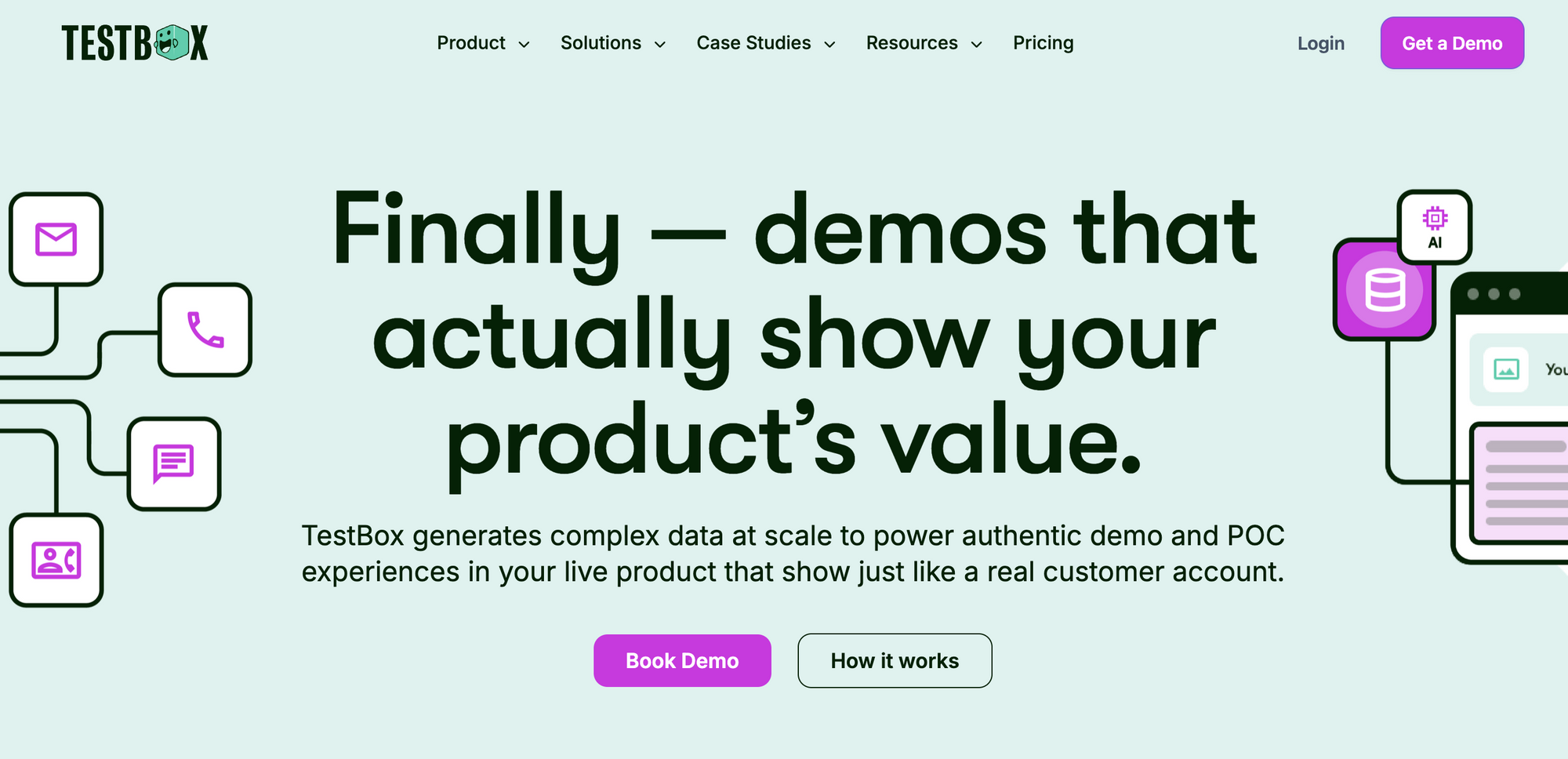
TestBox is a demo and proof-of-concept (POC) automation platform designed to transform how sales teams showcase their products. At its core, TestBox enables teams to generate authentic, fully functional product demonstrations and POCs in seconds rather than hours or days.
What sets TestBox apart is its ability to create personalized demo environments populated with complex, relevant data that resonates with each prospect's unique use case. This means sales teams can demonstrate their product's value in highly specific scenarios without the traditional headaches of manual demo environment setup and maintenance.
The software is more helpful to sales and solutions engineering teams due to TestBox's sandbox and product overlay functionality.
Similar to other interactive demo platforms in the market, TestBox captures the front end (the interface that’s visible to the users) of the software through HTML cloning. But, unlike a simpler and less technical Chrome extension, they have a built-in HTML capture technology that clones the front end of a software application.
TestBox's pricing plans
TestBox offers three-tiered pricing plans designed to accommodate different company sizes and demo complexity requirements. As a sales-led solution, all plans require connecting with their sales team to activate your account.
While specific pricing details may vary, here's an overview of their pricing structure:
Startup Plan
- Starting at $44,750/year for 15 users
- Ideal for early-stage companies
- Focused on basic demo and POC creation
- Best for single-product demonstrations
- Limited data and integration capabilities
Growth Plan
- Starting at $59,500/year for 15 users
- Designed for scaling companies
- Supports multiple product modules
- Handles complex data-driven workflows
- Includes third-party integration options
Enterprise Plan
- Custom pricing (contact sales)
- Built for large organizations
- Supports interconnected product suites
- Advanced data requirements and segmentation
- AI-powered workflow capabilities
Additional users can be added to any plan for approximately $1,200 per user per year. Implementation fees apply and vary based on the chosen package and specific requirements.
Note: TestBox doesn't offer a free trial. So, testing the tool before buying its plans is nearly impossible. TestBox's pricing also doesn't include a free plan for their demo automation software.
Key TestBox features
Next Steps: Build Better Interactive Demos
If you've made it this far... congrats! You should have a much better understanding of the top TestBox alternatives.

Ready to pick the right demo creation platform? While each tool we've reviewed has its own strengths, the best way to find your perfect fit is to experience it firsthand. Your choice should align with your specific needs, team structure, and budget.
Looking for a versatile platform that lets you create demos quickly for any scenario - whether it's web, desktop, or mobile apps? Give Supademo a test drive with the free trial. Our intuitive interface and rapid demo creation capabilities make it a standout choice for teams who value efficiency and flexibility.
FAQs
Why are teams exploring alternatives to TestBox?
TestBox offers live trial environments, but it often requires complex integrations, engineering effort, and longer setup times. Teams that want to create demos quickly—without sandboxing or back-end dependencies—often turn to lightweight, no-code alternatives like Supademo.
What are the best TestBox alternatives?
Some top alternatives include Supademo, Navattic, Storylane, and Demostack. Supademo stands out for its point-and-click simplicity, instant AI voiceovers, localization, and ability to create engaging product demos in minutes—no technical expertise required.
How does Supademo differ from TestBox?
TestBox relies on live product instances or cloned environments, which can be difficult to manage and scale. In contrast, Supademo lets you build step-by-step, interactive demos by simply clicking through your product—no cloning, integrations, or code involved.
Is Supademo easier to set up than TestBox?
Absolutely. Supademo can be used immediately after signup, with no engineering help or product access required. It’s perfect for marketing, sales, or onboarding teams who want to create and share demos quickly without technical delays.
Can Supademo demos be embedded like TestBox trials?
Yes. Supademo demos can be embedded on websites, help centers, landing pages, and emails, just like TestBox environments. You can also gate them with forms, capture engagement analytics, and personalize the experience for different audiences.
What types of teams benefit from using Supademo over TestBox?
Supademo is perfect for product marketers, sales teams, onboarding managers, and customer success—anyone who needs to build and share interactive product demos quickly. It’s especially valuable for teams that want to scale demo creation without developer involvement.


